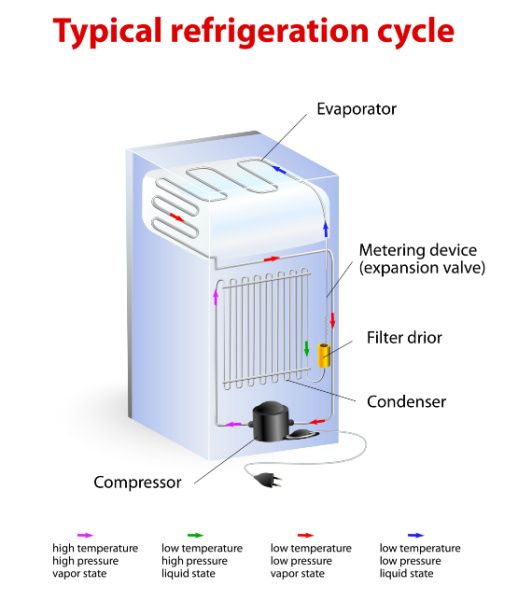Quick Links
Key Takeaways
Since fridges are not designed to handle the level of heat given off by a typical PC, it's probably not a good idea to stick your computer inside one if it's running too hot.
Your computer is hot, and your fridge is cold, so it makes sense to wonder if you can combine them. But can your refrigerator really handle a PC's heat, and is it even safe for your PC? Let's find out.
How a Fridge Works: The Basics
A fridge works by using a chemical called a "refrigerant" that absorbs heat from inside the fridge and releases it outside. Inside the fridge, there is a system of coils and a compressor.
The refrigerant is drawn into the compressor, where it's, well, compressed. It then flows into a set of coils called the condenser, where it releases its heat to the air outside the fridge and cools down, turning into a liquid again.
The liquid refrigerant flows through an expansion valve, which expands and cools it down even more, turning it into a cold, low-pressure gas.
The gas flows into another set of coils called the evaporator, where it absorbs heat from the air inside the fridge and warms up, turning it back into a gas. The warm gas flows back into the compressor, and the cycle starts again.
This continuous heating and cooling cycle keeps the inside of the fridge cold and the food inside fresh. These days there is also a newer type of "inverter" fridge which operates on the same principles, but unlike compressor fridges can vary the intensity at which it runs, rather than the crude on-off operating modes of a fridge compressor. Nonetheless, the cycle is the same.
Computers Can Get Too Warm for a Refrigerator
Even after learning how fridges work, it can still seem like some sort of magic. But what's clear is the fact that absorbed heat is getting moved out of the fridge compartment to be dissipated.
If we focus on that aspect and not the complicated phase change physics, the first problem with using a fridge to cool your PC rears its head. The fridge only has a set amount of heat it can absorb and move away from its interior.
In other words, if your PC is putting out more watts than the fridge can shift, the inside of the fridge will get hotter and hotter rather than cooling down. Since typical gaming PCs use hundreds of watts of energy, it's unlikely the typical fridge can handle it.
Below Ambient Cooling Is a Bad Idea
For the sake of argument, let's pretend that your fridge has no trouble moving the heat generated by a computer away and can actually cool its interior to typical fridge temperatures. Now you have to deal with water condensing from the air onto all sorts of components that really would rather not get wet.
This is why overclockers who use liquid nitrogen or other extreme cooling methods have to smear vaseline over everything and take multiple precautions to prevent condensation from shorting out components in the computer.
This brings up another fundamental problem with cooling a PC with a fridge. Fridges are designed to maintain a low temperature efficiently, not to remove heat from hot things. A CPU doesn't need to be colder than, say, 40C (104F) it just shouldn't be hotter than its maximum rated temperature. So the fundamental goals of PC cooling and refrigeration are different.
It would certainly be possible to design a refrigeration system that aligns more with the type of cooling PCs need, but since computers already have some efficient purpose-built cooling solutions, it doesn't make much sense.
We Already Have Fridge-ish Cooling In PCs
While sticking your PC in a fridge will likely fry the PC and maybe even the poor fridge, there's some kernel of a good idea there. In fact, using a phase-change process to cool PC components is common these days.
Both heat pipes and vapor chambers use a liquid sealed under low pressure to remove heat from hot components. Heat pipes move heat efficiently to where it can be removed from the system, and vapor chambers efficiently and continuously spread heat over a large surface to be dissipated.
You'll find both heat pipes and vapor chambers in laptops, consoles, graphics cards, and any other high-performance electronics where things get hot quickly.
In addition, there are thermoelectric coolers that use the Peltier effect to pump heat from one place to another. These devices are also known as solid-state refrigerators since they don't use refrigeration through a phase-changing refrigerant.
In short, don't stick your PC in a fridge or route refrigerated air through your PC case unless you're really looking for an excuse to buy a new computer.


